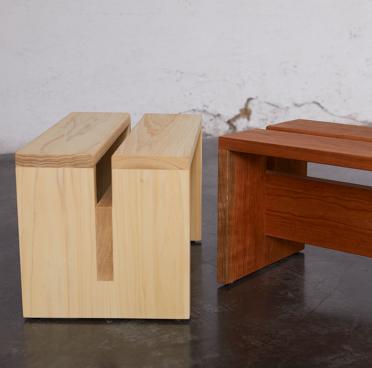Inestable, 1993
Reproduction in American red oak
A large table in American red oak, comprising several flat boards that can be stood upright, revealing concealed drawers and book rests to aid reading. The rounded perimeter of the table frames a Z-shaped structure that recalls both the ground plan of Barcelona’s Igualada Cemetery and the roofs of Parets del Vallès, as well Miralles’ own initials, E and M.
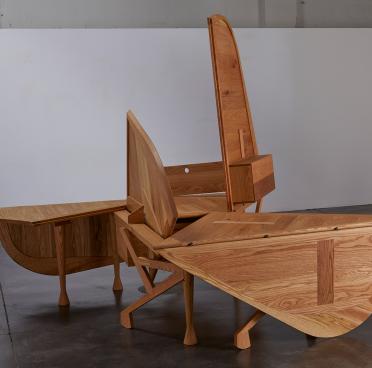
Lelukaappi, 1995
Reproduction in American maple and American cherry veneer
Originally designed for a play centre at Mollet del Vallès and representing the building in microcosm, this shelving unit is made of three articulated units of horizontal and vertical wooden shelves at different heights, which rotate on their common axes. Made using American maple veneer inlaid with cherry, all three are fitted with wheels, allowing for fluid movement. Like many of the shelves designed by Enric Miralles, Lelukaappi is characterised by its organic layout and its ability to surround the user, creating a cocoon in which to work, read or reflect.
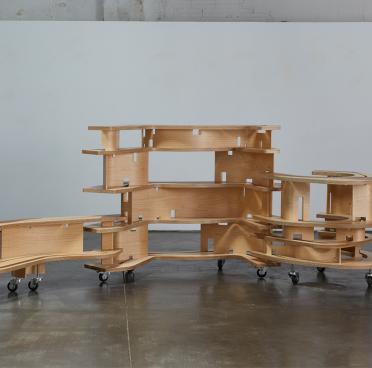
Troncs, 1998
Reproduction in American red oak
Made in collaboration with Benedetta Tagliabue for their home, the Troncs table has a simple mechanism that allows for the position of the legs to be changed, turning it from standard-height table to low bench. For Perpetuum Mobile it has been reproduced in American red oak.

Estudi, 1993
Reproduction in American red oak and cherry
Designed by Enric Miralles and Benedetta Tagliabue for their home, the Estudi table comprises two seating places, allowing the users to draw, design and talk while facing each other, and a large five-legged frame that supports a wooden worktop with a slot for electrical cables. A chest on wheels to store architectural plans is placed underneath. The Estudi table has been reproduced in American cherry with red oak accents. The drawer unit sits on castors and its front is made of vertically jointed cherry veneers.
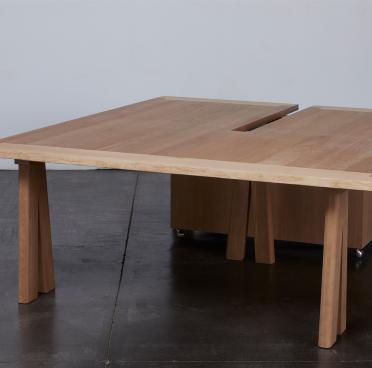
Marisa, 1992
Reproduction in American tulipwood plywood
Inspired by the typology of travel trunks, the Marisa shelves consist of two high units in edge-matched American tulipwood veneer that, through a series of hinges, close upon themselves, leaving the books and objects inside partially visible.
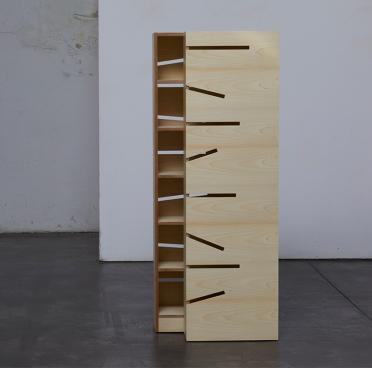
Mistery, 1999
Reproduction in American maple
The Mistery table had never been built. Benedetta Tagliabue rescued the plans from her home archive, after finding them by chance. It has been redrawn and produced specifically for this exhibition.
It is a drawing table that can be lengthened or shortened by a system that folds in a zigzag, transforming from a work space for one to a dining table for up to 16 people. When open, it is a large table of more than 4m, and whilst closed it becomes a drawing table on which books and plans can sit. Its movement is reminiscent of a rower in a canoe.
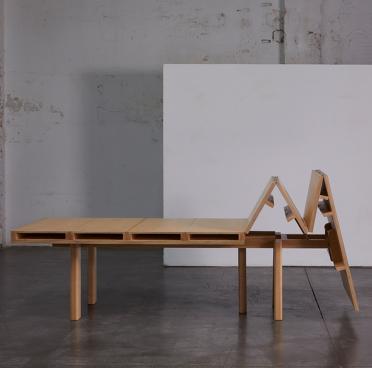
Tropical, 1994
Reproduction in American red oak
Another collaboration with Tagliabue, the Tropical table has two possible heights, 70 cm or 35cm, so that it can do double duty as both dining and coffee table. The height can be adjusted by leaning on the table’s four legs, which act like the pillars of a drawbridge, supported by a cross-joined frame. The reproduction has been made in American red oak with an oil finish.
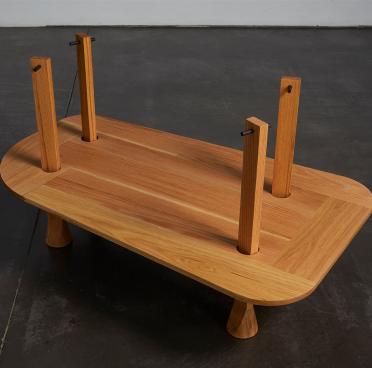
Dolmen, 1995
Reproduction in American cherry and tulipwood
The Dolmen table responds to restaurant tables that fold vertically when not in use. When open, Dolmen can be used for work, aided by the drawers underneath. When folded, it forms a movable wall that can be used as a room divider. The table’s menhir-shaped worktop comprises eight boards of solid American cherry, arranged diagonally, and attached to the lower part of the table by a cross-shaped frame made of American tulipwood. The lower part of the piece is made up of three legs, one of which has two pivoting arms that allow the table to be collapsed.
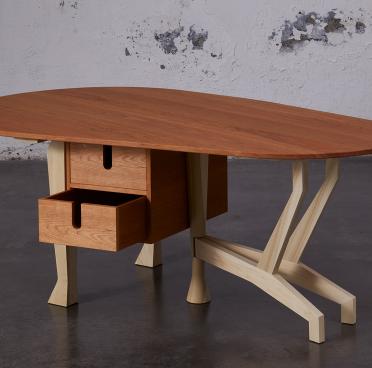
Japonès Stool, 1992
Reproduction in American red oak, tulipwood, maple and cherry
Created after a trip to Japan by Miralles and Tagliabue, inspired by the traditional Japanese shower stool, the Japonès Stool is a very simple piece of furniture that fully expresses its structural composition, with no hidden joints. The stool has a slot on the top making it easy to transport, and can be placed either on two legs or on its side. For Perpetuum Mobile, stools have been reproduced in American red oak, tulipwood, maple and cherry with an oil finish.
